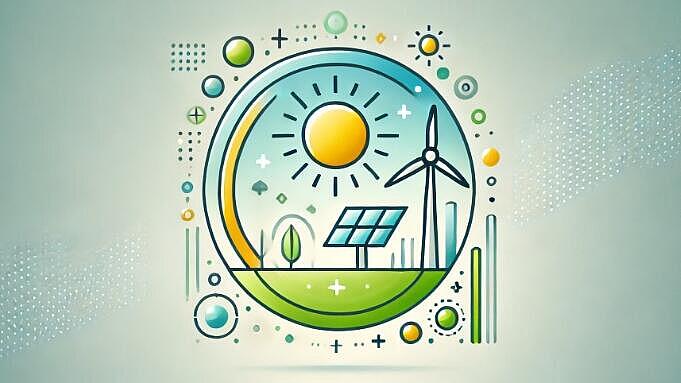 Política & Regulação
Política & RegulaçãoEurope's Energy Transition: Leading the Charge, Overcoming the Hurdles
Resumo
Europe has secured a leading role in the global renewable energy landscape, propelled by its commitment to the European Green Deal and REPowerEU plan, which have bolstered the development and usage of renewables like solar, wind, and bioenergy. In 2022, the EU achieved significant milestones by reducing reliance on Russian fossil fuels and enhancing renewable energy capacity, although it faces competition from countries like China and the U.S.
Policy measures like Fit-for-55 and REPowerEU have been crucial in this rapid shift, featuring regulatory reforms, fiscal incentives, and streamlined permitting to boost renewable energy deployment. The geopolitics following the invasion of Ukraine prompted the EU to cut Russian gas imports significantly, spurring investments in renewable energy and storage to enhance energy security and decarbonization.
Yet, Europe grapples with challenges such as higher energy costs compared to other regions and sluggish energy efficiency improvements, highlighting areas in need of strengthened policy responses and technology investment. Policy frameworks remain vital, driving clean energy investments despite regulatory hurdles and local opposition, which policymakers are addressing by simplifying regulations and enhancing community engagement.
Europe's transition is reinforced by international cooperation, exemplified by commitments like the COP28 agreement, and strategic partnerships to obtain raw materials crucial for renewables. Despite existing challenges, Europe's policy foundations and intention for global collaboration signal a strong path ahead for a sustainable energy future, assuming it can navigate issues related to costs and regulation effectively.
Artigo aberto completo
Europe's Energy Transition: Leading the Charge, Overcoming the Hurdles
Europe’s Leadership in Renewable Energy
Europe has emerged as a global leader in renewable energy, setting ambitious goals and making significant strides toward decarbonization. The European Union (EU) has spearheaded this progress through key initiatives such as the European Green Deal and the REPowerEU plan. These efforts have accelerated the development of solar, wind, and bioenergy sources, making the continent a major player in global renewable energy capacity.
In 2022, the EU surpassed several key REPowerEU targets, including a dramatic reduction in Russian fossil fuel imports and the installation of substantial renewable energy capacity. While Europe is leading in policy and infrastructure for renewables, other global powers like China and the United States are catching up due to their market size and ability to quickly scale renewable energy projects.
Factors Driving Europe’s Energy Transition
Several factors have contributed to Europe's rapid transition to clean energy. Policy frameworks like Fit-for-55 and REPowerEU have been critical, driving a substantial increase in renewable energy deployment and efficiency improvements. Regulatory reforms, fiscal incentives, and streamlined permitting processes have further accelerated the growth of solar and wind energy across the continent.
The political push to reduce dependence on Russian fossil fuels has been another major catalyst. Following the invasion of Ukraine, the EU swiftly reduced Russian gas imports from 45% to 18% of its total gas supply between 2021 and mid-2024. This geopolitical shift motivated substantial investment in renewables and energy storage, enhancing Europe’s energy security while advancing its decarbonization efforts.
Challenges and Areas of Slower Progress
Despite its leadership in renewables, Europe faces several challenges that have slowed certain aspects of its energy transition. One of the most pressing issues is the high cost of energy, which remains significantly higher than in regions like the United States. For example, European gas prices are up to six times higher than in the U.S., a factor that threatens the competitiveness of energy-intensive industries.
Moreover, energy efficiency progress in Europe has lagged behind other regions. While Oceania achieved a 7% improvement in energy intensity, Europe and North America managed only a 0.2% improvement. This slower pace of efficiency gains poses a challenge to Europe’s overall energy transition, underscoring the need for more robust policy measures and investments in efficiency technologies.
The Role of Policy and Regulation
Policy and regulation are central to Europe’s energy transition. The European Green Deal and REPowerEU provide comprehensive strategies to reduce emissions, improve energy efficiency, and increase the share of renewables in the energy mix. These policy frameworks have been instrumental in driving investments in clean energy and energy efficiency.
However, regulatory challenges remain. For example, complex permitting processes for renewable energy projects, particularly wind farms, have led to delays. Local opposition to infrastructure developments also plays a role in slowing progress. To address these issues, European policymakers are working to simplify regulations and improve community engagement.
In addition to streamlining regulations, the EU is focusing on building a skilled workforce to support the energy transition. Initiatives like the Net-Zero Industry Academies aim to develop expertise in critical sectors like hydrogen, batteries, and solar power, ensuring that Europe has the talent needed to achieve its ambitious energy goals.
International Cooperation and Global Comparisons
Europe’s energy transition is part of a broader global effort to combat climate change and promote clean energy. The EU has played a leading role in international initiatives, including the COP28 agreement, which aims to triple global renewable energy capacity by 2030. Europe’s active participation in such global frameworks highlights the importance of international cooperation in addressing the climate crisis.
Beyond policy, Europe has established partnerships with countries outside the EU to secure access to critical raw materials like lithium and rare earth elements, which are essential for renewable energy technologies. These partnerships help Europe maintain its leadership in clean energy while supporting sustainable practices in the global supply chain.
Conclusion: A Path Forward for Europe
Europe’s energy transition showcases both significant achievements and ongoing challenges. While the continent leads in renewable energy deployment and policy innovation, issues such as high energy costs, regulatory delays, and slow progress in energy efficiency remain. Despite these obstacles, Europe’s ambitious policies, such as the European Green Deal and REPowerEU, lay a strong foundation for continued progress.
Looking ahead, global collaboration will be key to accelerating the energy transition, as evidenced by agreements like COP28. Europe’s leadership in renewable energy and its commitment to policy innovation position the region as a critical player in the global fight against climate change. By addressing challenges like energy costs and regulatory bottlenecks, Europe can continue to lead the world toward a sustainable, clean energy future.
With the right mix of policy action, investment, and international cooperation, Europe is well-positioned to meet its 2030 climate goals and set a global example in the energy transition.
Sources
https://www.iea.org/reports/tracking-sdg7-the-energy-progress-report-2024
https://energy.ec.europa.eu/topics/energy-strategy/energy-union/ninth-report-state-energy-union_en



